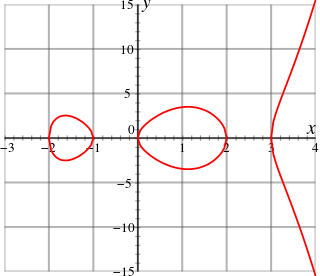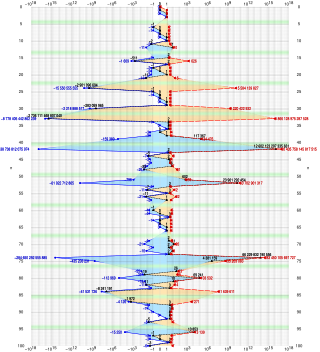Hypercomputation or super-Turing computation is a set of hypothetical models of computation that can provide outputs that are not Turing-computable. For example, a machine that could solve the halting problem would be a hypercomputer; so too would one that could correctly evaluate every statement in Peano arithmetic.

In algebraic geometry, a hyperelliptic curve is an algebraic curve of genus g > 1, given by an equation of the form
In quantum computing, a quantum algorithm is an algorithm that runs on a realistic model of quantum computation, the most commonly used model being the quantum circuit model of computation. A classical algorithm is a finite sequence of instructions, or a step-by-step procedure for solving a problem, where each step or instruction can be performed on a classical computer. Similarly, a quantum algorithm is a step-by-step procedure, where each of the steps can be performed on a quantum computer. Although all classical algorithms can also be performed on a quantum computer, the term quantum algorithm is generally reserved for algorithms that seem inherently quantum, or use some essential feature of quantum computation such as quantum superposition or quantum entanglement.
Algorithmic topology, or computational topology, is a subfield of topology with an overlap with areas of computer science, in particular, computational geometry and computational complexity theory.
In mathematics, the Bernstein–Sato polynomial is a polynomial related to differential operators, introduced independently by Joseph Bernstein and Mikio Sato and Takuro Shintani, Sato (1990). It is also known as the b-function, the b-polynomial, and the Bernstein polynomial, though it is not related to the Bernstein polynomials used in approximation theory. It has applications to singularity theory, monodromy theory, and quantum field theory.
This is a glossary of arithmetic and diophantine geometry in mathematics, areas growing out of the traditional study of Diophantine equations to encompass large parts of number theory and algebraic geometry. Much of the theory is in the form of proposed conjectures, which can be related at various levels of generality.

In mathematics, the unknotting problem is the problem of algorithmically recognizing the unknot, given some representation of a knot, e.g., a knot diagram. There are several types of unknotting algorithms. A major unresolved challenge is to determine if the problem admits a polynomial time algorithm; that is, whether the problem lies in the complexity class P.
Algorithmic Number Theory Symposium (ANTS) is a biennial academic conference, first held in Cornell in 1994, constituting an international forum for the presentation of new research in computational number theory. They are devoted to algorithmic aspects of number theory, including elementary number theory, algebraic number theory, analytic number theory, geometry of numbers, arithmetic geometry, finite fields, and cryptography.

The following tables list the computational complexity of various algorithms for common mathematical operations.
Arithmetic dynamics is a field that amalgamates two areas of mathematics, dynamical systems and number theory. Part of the inspiration comes from complex dynamics, the study of the iteration of self-maps of the complex plane or other complex algebraic varieties. Arithmetic dynamics is the study of the number-theoretic properties of integer, rational, p-adic, or algebraic points under repeated application of a polynomial or rational function. A fundamental goal is to describe arithmetic properties in terms of underlying geometric structures.
In mathematics, arithmetic combinatorics is a field in the intersection of number theory, combinatorics, ergodic theory and harmonic analysis.
In the mathematical field of algebraic geometry, an elliptic curve E over a field K has an associated quadratic twist, that is another elliptic curve which is isomorphic to E over an algebraic closure of K. In particular, an isomorphism between elliptic curves is an isogeny of degree 1, that is an invertible isogeny. Some curves have higher order twists such as cubic and quartic twists. The curve and its twists have the same j-invariant.

Christopher Deninger is a German mathematician at the University of Münster. Deninger's research focuses on arithmetic geometry, including applications to L-functions.
In algebraic geometry and number theory, the torsion conjecture or uniform boundedness conjecture for torsion points for abelian varieties states that the order of the torsion group of an abelian variety over a number field can be bounded in terms of the dimension of the variety and the number field. A stronger version of the conjecture is that the torsion is bounded in terms of the dimension of the variety and the degree of the number field. The torsion conjecture has been completely resolved in the case of elliptic curves.

Alan Stuart Edelman is an American mathematician and computer scientist. He is a professor of applied mathematics at the Massachusetts Institute of Technology (MIT) and a Principal Investigator at the MIT Computer Science and Artificial Intelligence Laboratory (CSAIL) where he leads a group in applied computing. In 2004, he founded a business called Interactive Supercomputing which was later acquired by Microsoft. Edelman is a fellow of American Mathematical Society (AMS), Society for Industrial and Applied Mathematics (SIAM), Institute of Electrical and Electronics Engineers (IEEE), and Association for Computing Machinery (ACM), for his contributions in numerical linear algebra, computational science, parallel computing, and random matrix theory. He is one of the creators of the technical programming language Julia.
Toby Stephen Gee is a British mathematician working in number theory and arithmetic aspects of the Langlands Program. He specialises in algebraic number theory.

Jennifer Shyamala Sayaka Balakrishnan is an American mathematician known for leading a team that solved the problem of the "cursed curve", a Diophantine equation that was known for being "famously difficult". More generally, Balakrishnan specializes in algorithmic number theory and arithmetic geometry. She is the Clare Boothe Luce Associate Professor at Boston University.

In the mathematics of sums of powers, it is an open problem to characterize the numbers that can be expressed as a sum of three cubes of integers, allowing both positive and negative cubes in the sum. A necessary condition for an integer to equal such a sum is that cannot equal 4 or 5 modulo 9, because the cubes modulo 9 are 0, 1, and −1, and no three of these numbers can sum to 4 or 5 modulo 9. It is unknown whether this necessary condition is sufficient.
In mathematics, a sparse polynomial is a polynomial that has far fewer terms than its degree and number of variables would suggest. For example, x10 + 3x3 − 1 is a sparse polynomial as it is a trinomial with a degree of 10.











